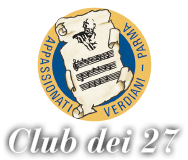The monument was begun in 1913, centenary of the birth of Giuseppe Verdi, and inaugurated on 22nd February 1920; it was situated in front of the station using the project of Lamberto Cusani. The monument used the classical form of the triumphal arch surmounted by lions pulling a mythological chariot; the arch joined the two sides of an arcaded hemicycle in between the columns of which were placed the 28 statues representing the works of Maestro Verdi as realized by the Palermitan sculptor Ettore Ximenes. Here follows a list of the sculptures: Oberto, Conte di San Bonifacio (extant), Un Giorno di Regno, Nabucco, I Lombardi alla Prima Crociata, Ernani (extant), i Due Foscari, Giovanna d’Arco, Alzira (extant), Inno di Guerra (extant), Attila, Macbeth (extant), I Masnadieri (extant), il Corsaro, La Battaglia di Legnano (extant), Luisa Miller, Stiffelio, Rigoletto, il Trovatore, La Traviata, I Vespri Siciliani, Simon Boccanegra, Un Ballo in Maschera, La Forza del Destino, Don Carlos (extant), Aida (extant), Messa da Requiem, Otello, Falstaff. The whole construction was slightly damaged in the allied bombing raid of 1944 and was dismantled immediately after the war. The nine sculptures which survived destruction were placed in the Cinema of Roccabianca “Arena del Sole” where they can still be seen today. Their transport and survival was down to the activity of Dr. Mario Tommasinelli. Of the remaining sculptures the preparatory drawings by Ximenes are on display at the Academy of Beaux Arts in Parma.
Of the majestic monumental complex only the central altar area in granite with bronze high reliefs by Ximenes remains sited next to the flying buttresses of the Farnese Palace of the Pilotta in Piazzale della Pace. On the front part of the Verdi altar can be seen a bronze high relief showing Verdi in meditation surrounded by the Muses, Melody, Song, Dance Rhythm, Love and Death, who seem to be whispering inspiration.
The other side of the monument holds three further bronze high reliefs: to the left is the scene in which the results of the unanimous vote of the Parma Provincial area held on 12th September 1859 to accede to the Kingdom of Italy are announced. The central relief is the joyful welcome reserved for Verdi on his arrival in Turin as delegate from Parma to present to the King the results of the plebiscite…..kindly note the famous acronym VIVA VERDI standing for Vittorio Emanuele Re d’Italia (long live Victor Emanuel King of Italy). To the right can be seen Verdi and other important people delivering to King Vittorio Emanuele on 15th September 1859 the plebiscite results in which the Emilian provinces adhered to Piedmont.
The three high reliefs are illustrated by an epigraph suggested by Senator Mariotti: “ On this altar/ sacred to the unity of the fatherland/ by unanimous vote of the people’s representatives/ Giuseppe Verdi and other people of spirit/ Parma /rebels to the prohibitions of Villafranca and Zurich/the centuries old autonomy and Ducal crown/placed/ on XII September MDCCCLIX/ that vote of a free people/ celebrating the new, great fortunes of Italy/Giuseppe Verdi went to the Great King/the XV September MDCCCLIX.
